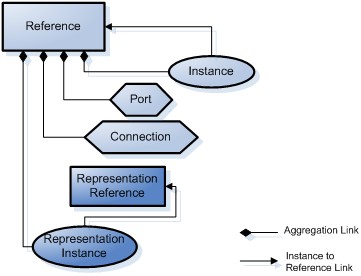PLM Core Model Overview | ||
| ||
Unified Model
To support PLM (Product Life cycle Management) across all types of application, a unified model is created with six classes implementing life cycle operations (versioning, maturity, etc).
The classes that form the PLM Core Model are:
- Reference
- Instance
- Port
- Connection
- Representation Reference
- Representation Instance
This model, based on the Entity-Relationship model, is kept simple as each class is clearly designed for a concise and specific usage.
These six classes are in turn specialized by component modelers (henceforth referenced to as modelers) to create their own types. These types can extend the core's behavior but not supersede it, thus always ensuring that basic life cycle operations implemented by the core are unbreakable (the core's behavior will always be carried out, no matter how it is extended.)
A modeler specialization is defined using declarative means in the PLM dictionary, with these declarations being projected in a second stage to the database. A modeler can also declare that its types can be further customized by end users with tools like DMC Tool and the same PLM Dictionary, enabling an agile PLM Core model.
A compact set of core classes combined with basic services (see following section) contributes to make the PLM core highly optimized and efficient, benefiting all modelers.
![]()
Common Capabilities
All the PLM Core classes support the following capabilities:
- The ability to be specialized by modelers or customized by end-users. Remember that attributes, relations or behavior can only be augmented but not superseded.
- The basic PLM operations such as Create, Update and Delete (CrUD) and the life cycle management.
- Three kinds of possible relations:
- Aggregation
- Instance Of
- Referencing
- The ability to store private data as multiple streams in a vault.
A PLM component is defined as a single entity with its identification, to which are appended satellite PLM information units like extensions, vault links, relations and lists. A given satellite unit can only belong to one and only PLM component.
Such a PLM component is considered to be the atom of concurrent modification, implying that:
- A modification of the PLM entity or of one of its satellites is viewed as a modification of the PLM component
- Modifications of a component are serialized: only one modification at a time is allowed. No concurrent modification is thus possible on a given component.
![]()
PLM Reference
This diagram illustrates all the PLM Core components and how they fit together:

Reference
The Reference is the PLM building block.

Specifically, it:
- Can be used/resused
- Is a Separable component, i.e. must exist by itself
- Can aggregate other components
- Cannot be aggregated
- Carries a maturity
- Is versionable
- Duplicating or versioning a Reference is to duplicate itself and its aggregated objects (instances/connection/port/ and its mono-instantiable Representation Reference)
![]()
PLM Port
The Port provides a stable abstraction of private data to the outside, isolating both parties (the outside and the private data) from each other

- Is aggregated by a Reference (not Separable)
- Exposes an Instance, another Port, or representation
- Carries a single referencing relation to the exposed object
- Offers a stable name
![]()
PLM Connection
The Connection models semantic relationships between components.

- Is aggregated by a Reference (not Separable)
- Connects entitites through multiple referencing relations


